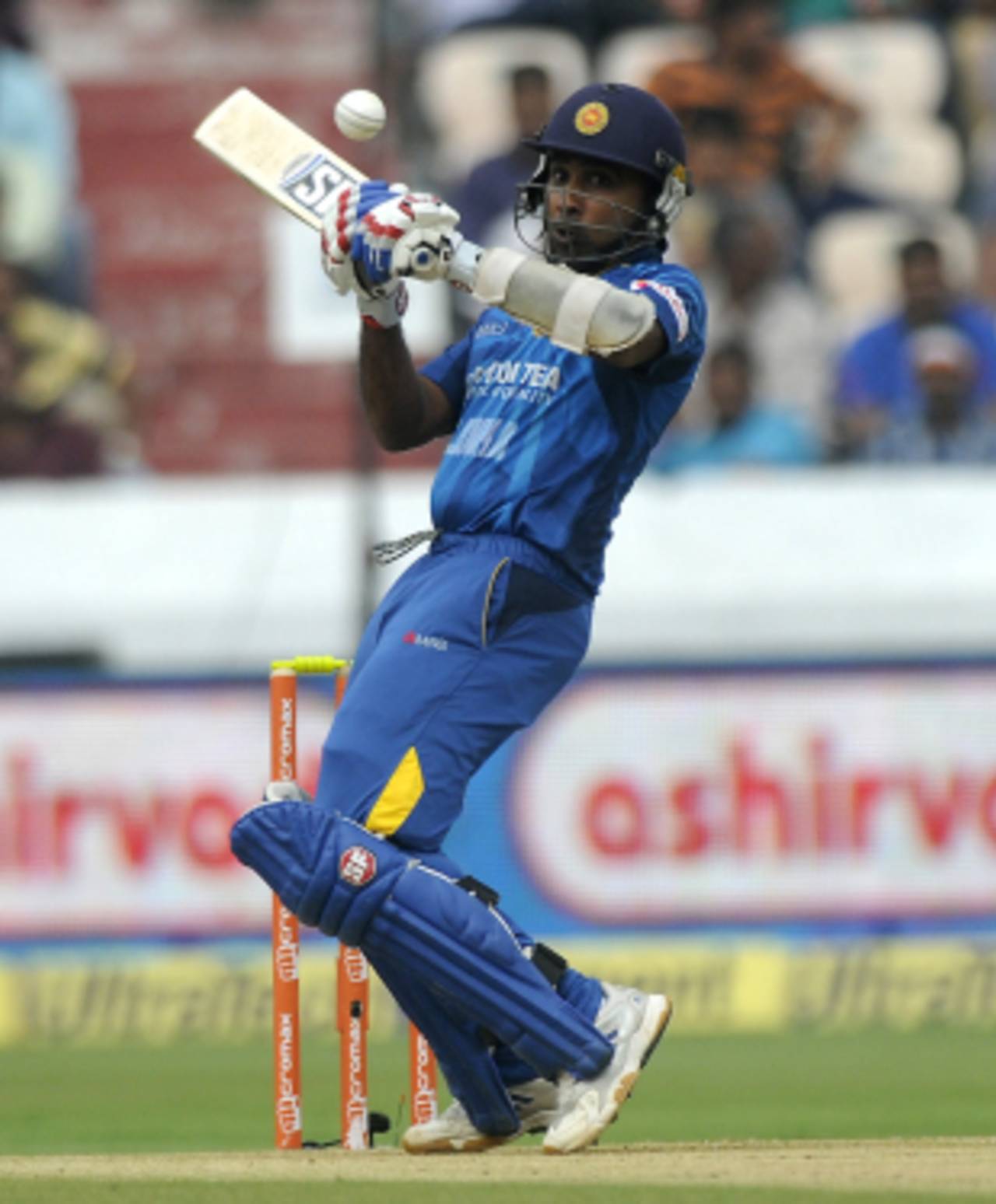Jayawardene curbed by middle-management problem
As valuable as he is in the middle order, Mahela Jayawardene has expressed a willingness to open the innings and perhaps it is time Sri Lanka allow his flamboyance to find full expression at the top of the order
Andrew Fidel Fernando
11-Nov-2014

Sri Lanka have much to gain from sending Mahela Jayawardene at the top of the order • BCCI
The Sri Lanka team likes to please its supporters. For months, younger batsmen have tripped and fallen cheaply at the top of the innings, and a public grumble has been growing: Shouldn't Mahela Jayawardene be facing the new ball? It would seem the fans have been heard. In all three matches against India so far, Jayawardene has been in the middle within the first 15 overs. In the last match, he and Tillakaratne Dilshan came together 2.2 overs in, to forge the first three-figure partnership of Sri Lanka's tour.
The debate over misfiring openers has been chewed over so often since 2012, it is now almost passé to lay the figures out. Even while Dilshan has been one of the most consistent batsmen in the world in that period, his most frequent partners - Upul Tharanga and Kusal Perera - have averaged 26.5 and 24.6, atop the innings, respectively. Jayawardene's prowess against the new ball has also been well-explored. He averages 44.8 when he opens - almost 10 higher than at his usual haunt at second drop. The only mild surprise is that Jayawardene's strike rate of 91 as an opener is even better than Dilshan's.
Jayawardene has expressed a desire to open but his problem now is a classic of the corporate world: he is too valuable in his present role to get the job he really wants. Only, he can't even sound out a competitor and change jobs. It is like a Dilbert comic, or a scene out of Office Space. Seventeen years for the same firm, and he is still being curbed by middle management.
Asked recently if Jayawardene might open in light of the recent troubles finding a partner for Dilshan, Angelo Mathews said Sri Lanka were "not that desperate". In the past, Jayawardene's promotions have largely been last-resort hikes up the order, to fill-in for an injured opener, or replace a misfiring batsman in the middle of the tour. Only, it quickly became evident that the same forces that unlocked Dilshan's full potential when he began to open, were at work on Jayawardene as well.
There are other attacking players Sri Lanka could deploy against the new ball, including Kusal, but none have as much experience or cricket nous to gauge the conditions and the opposition, to discern when the aggression must be dialled down. That is a critical skill in the two-new ball era.
With little situational pressure closing him in, Jayawardene's flamboyance found full expression. Sri Lanka had begun earning rapid starts, not through Sanath Jayasuriya's homespun shellackings or Dilshan's whirring blade, but through calculation, precision and finesse. Bowlers have not found Jayawardene and Dilshan's jarring styles easy to handle, giving away 50.6 runs to the pair, on average.
It is easy to sympathise with Mathews. When Jayawardene opens the innings, the middle-order loses its buffer. If early wickets fall, Mathews might find he has to bat alongside the inexperienced batsmen currently laying claim to the spots around him, or with the tail. He has become adept at handling both these scenarios, but they are nobody's first choice. Thisara Perera, Seekkuge Prasanna and Nuwan Kulasekara are not ideal partners before the 40th over. The likes of Dinesh Chandimal and Ashan Priyanjan have glinted briefly, then dimmed.
But then, Sri Lanka have so much to gain from sending Jayawardene to the top. For one, they could do with some edge from that opening pair, now that Dilshan, the dasher, has gradually adopted a more measured mode of operation (since his breakthrough 2009, his strike rate has dropped each year, while his output has increased). There are other attacking players Sri Lanka could deploy against the new ball, including Kusal, but none have as much experience or cricket nous to gauge the conditions and the opposition, to discern when the aggression must be dialled down. That is a critical skill in the two-new ball era. There is also no one else who, unburdened, can play long, defining innings and transform pressure situations.
This is not to say Kusal or Tharanga should be dispensed with completely. Kusal was a middle-order batsman for his club before Sri Lanka sought to make a Jayasuriya redux out of him, and Tharanga has also had moderate success in the middle order. If Jayawardene moves up, there is a place to fill at No. 4, and perhaps lower down as well.
But it is the last shot at a World Cup for so many players who have come close twice, and tasted failure. Jayawardene and Kumar Sangakkara have effectively confirmed they will not play after the World Cup. Dilshan and Rangana Herath will not be around in 2019 either. Maybe Sri Lanka owe it to their senior players to give them what they really want, and to set them roles in which they flourish.
The team's supporters have also long known Sri Lanka play their best cricket when they embrace aggression; when they are emboldened by opportunity, rather than tempered by risk. Maybe it's time to give the fans what they really want, as well.
Andrew Fidel Fernando is ESPNcricinfo's Sri Lanka correspondent. @andrewffernando